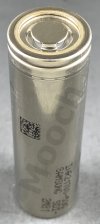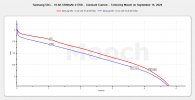These tests below only note my personal opinion for the ESTIMATED ratings for the batteries I tested at the time I tested them. Any battery that is not a genuine Samsung, Sony, Murata, LG, Panasonic, Molicel, EVE, Lishen, BAK, or Sanyo can change at any time! This can be one of the hazards of using “rewrapped” or batteries from other manufacturers so carefully research any battery you are considering using before purchasing.
Misusing or mishandling lithium-ion batteries can pose a SERIOUS RISK of property damage, personal injury, or even death. Never use them outside of a fully protected battery pack and you use them at your own risk. Never exceed the battery’s true continuous discharge rating (CDR), never let it get colder than 0°C or hotter than 60°C, and keep the plastic wrap and top insulating ring in perfect condition. Never use a battery that is physically damaged in any way.
Testing batteries at their limits is dangerous and should never be attempted by anyone who has not thoroughly studied the dangers involved, understands the risks, has the proper equipment, and takes all appropriate safety precautions.
If the battery has only one current rating number, or if it only says "max", then I have to assume the battery is rated at that current level for any type of discharge, including continuous.




Test Results
This is a great performing cell but a couple other lower capacity cells have the same run time or longer. It’s not a high performance energy cell but it does have a long (and confusing) cycle life spec in the datsheet. IMO it’s best used at up to 5A (about 15W) or so to avoid any voltage sag that counteracts its higher capacity.
My thoughts and results below…
Continuous Current Discharge Graphs

Ratings and Performance Specs Graphic

18650 Ratings and E-Scores Table:

 www.e-cigarette-forum.com
www.e-cigarette-forum.com
20700/21700 Ratings and E-Scores Table:

 www.e-cigarette-forum.com
www.e-cigarette-forum.com
I want to work for the community full time! If you feel what I do is worth a couple dollars a month and you would like early access to battery availability, battery testing and news, and a say in what I test, then please consider becoming a patron and supporting my testing efforts: Get more from Battery Mooch on Patreon.
To see how other cells have tested check out this link: Links To All 21700, 26650, 18350, 18500 Battery Tests
Misusing or mishandling lithium-ion batteries can pose a SERIOUS RISK of property damage, personal injury, or even death. Never use them outside of a fully protected battery pack and you use them at your own risk. Never exceed the battery’s true continuous discharge rating (CDR), never let it get colder than 0°C or hotter than 60°C, and keep the plastic wrap and top insulating ring in perfect condition. Never use a battery that is physically damaged in any way.
Testing batteries at their limits is dangerous and should never be attempted by anyone who has not thoroughly studied the dangers involved, understands the risks, has the proper equipment, and takes all appropriate safety precautions.
If the battery has only one current rating number, or if it only says "max", then I have to assume the battery is rated at that current level for any type of discharge, including continuous.




Test Results
This is a great performing cell but a couple other lower capacity cells have the same run time or longer. It’s not a high performance energy cell but it does have a long (and confusing) cycle life spec in the datsheet. IMO it’s best used at up to 5A (about 15W) or so to avoid any voltage sag that counteracts its higher capacity.
My thoughts and results below…
- The LG M50LT runs for a bit longer at both 5A and 10A.
- This cell has the same run time as the Samsung 50S at 5A but the 50S beats this cell by a little bit at 10A.
- The datasheet says at least 1000 cycles at 1.75A charge/5.3A discharge before dropping to 80% of its original capacity. This is great! And the actual cycle life will most likely be a lot longer. But this spec is for charging to 4.15V and the discharge is stopped at 3.0V. If fully charging and going all the way down to 2.5V (as most cells are specified) then the datasheet says that cycle life is affected but doesn’t say by how much.
- The thing that confuses me a bit is that any cell will have a longer cycle life if only used between 3.0V-4.15V. I guess this is just Samsung’s way of saying that this cell should really only be used gently and within a narrower voltage range? I don’t know. I don’t think its cycle life will be worse than other cells though if running it from 2.50V-4.20V and almost no applications do that anyway.
- If you can get it at a lower price than the Samsung 50S and LG M50LT this is a great performing cell worth considering. If you’re always running up at near 10A though then those other two cells are probably the better choice. Test them in your application to be sure.
- DC IR measured 27.4mOhms and 28.5mOhms for two cells. This is average consistency for a high capacity cell.
- Capacities were 5218mAh and 5226mAh, which is great consistency but below this cell’s 5300mAh “typical” capacity rating. It is above the 5140mAh “minimum” rating though. I’m rating this cell at 5200mAh.
- There is only one charge rating in the datasheet, 1.75A. I recommend not going over this to prevent extra aging of the cell.
Continuous Current Discharge Graphs

Ratings and Performance Specs Graphic

18650 Ratings and E-Scores Table:
18650 Battery Ratings and Performance Table
You are responsible for your own safety! These batteries are designed, manufactured, and sold only for use in a battery pack with the proper protection circuitry and battery management system. They were not designed for vaping (electronic...
 www.e-cigarette-forum.com
www.e-cigarette-forum.com
20700/21700 Ratings and E-Scores Table:
21700 Battery Ratings and Performance Table
You are responsible for your own safety! These batteries are designed, manufactured, and sold only for use in a battery pack with the proper protection circuitry and battery management system. They were not designed for vaping (electronic...
 www.e-cigarette-forum.com
www.e-cigarette-forum.com
I want to work for the community full time! If you feel what I do is worth a couple dollars a month and you would like early access to battery availability, battery testing and news, and a say in what I test, then please consider becoming a patron and supporting my testing efforts: Get more from Battery Mooch on Patreon.
To see how other cells have tested check out this link: Links To All 21700, 26650, 18350, 18500 Battery Tests
